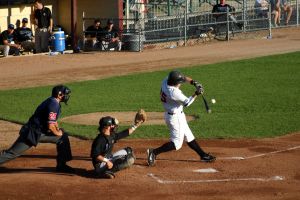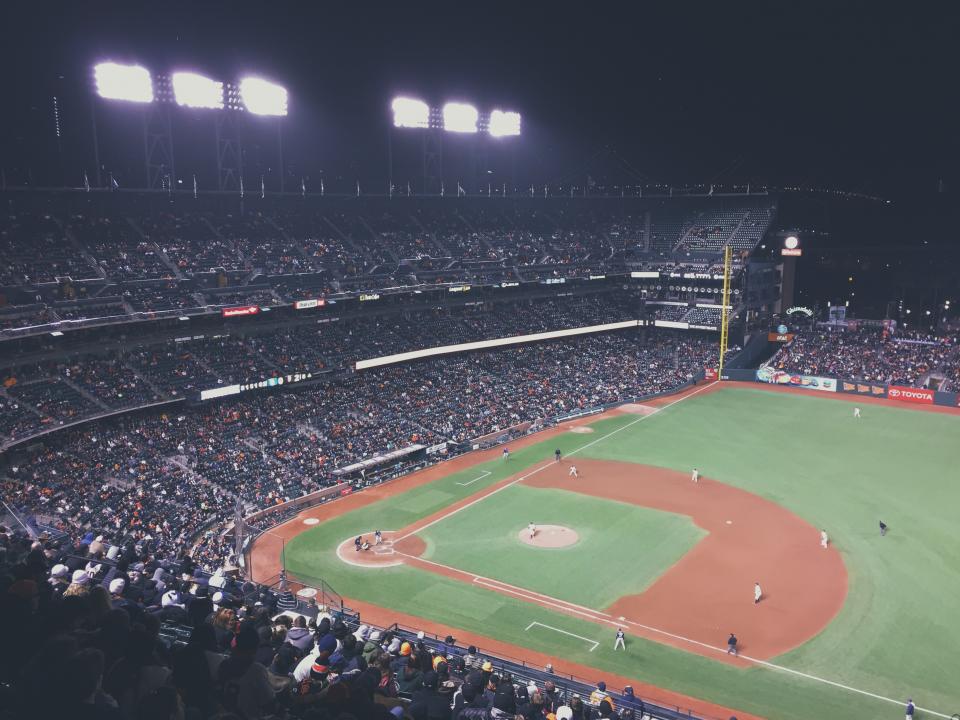
Today’s topics: What is a foul ball in baseball and softball? Is a foul ball a strike?
Howdy friends and welcome back!
As the MLB season is wrapping up, I thought we would continue with our baseball 101 articles where we have been explaining the rules of the game.
We have covered quite a few topics recently and I hope you have enjoyed them as much as I have enjoyed putting them together.
As we move through the off-season, I will try to put together as many articles as I can and cover as many of the rules as possible.
Remember that if you ever need some clarification about a certain rule, terminology, stat or product, you can leave a comment at the bottom of any post or head over to Ask Jeremy and I will be more than happy to help.
If you’re new to the game Check Out Simple Baseball Rules for a look at all the basics that will give you a good start.
So without further ado, let’s get started.
What Is A Foul Ball?
A foul ball is any pitch that a batter hits outside of the field of play that does not make contact with a player who is inside the field of play.
It does not matter how the ball is hit.
If the batter is bunting, swinging or even if they are ducking out of the way of a wild pitch. If the bat hits the ball and it goes foul, it is a “foul ball.”
When a foul ball is called, it also signifies the end of action (dead ball). The umpire will call “time out” and no further action can take place until the ump signals “time in.”
Speaking of getting out of the way of a wild pitch, this is why I teach kids right from the start to always bring the bat down when their turning away from a bad pitch.
Nothing is more frustrating than hitting the ground because the pitcher threw a pitch at your head, only to have the ball hit your bat and you are rewarded with a strike!
1st base – 3rd base & The Foul Poles

Think of the white chalk lines that you see on the field as boundaries.
When a ball is hit within the boundaries of the chalk lines, it is a “fair ball” and it is then up to the defense to try and get an out.
1st & 3rd base are the boundaries for balls hit in the infield.
If a batter hits a ball on the ground and it goes foul before reaching 1st or 3rd base, then it will be considered a “foul ball.”
If a batter hits a ball into the outfield and it hits the ground within the chalk line, it is a “fair ball.”
Unlike the infield, even if the ball rolls foul after hitting the ground inside the chalk line, it will still be a fair ball.
Any ball that is hit in the air and lands anywhere outside of the chalk lines is a foul ball.
The exception to the rules would be this:
“If the ball comes into contact with any player inside the chalk lines before the ball goes foul, it will become a fair ball.”
You will also notice the tall poles on each side of the outfield fence. Think of these as extensions of the chalk lines.
The foul poles are used to determine whether or not a ball hit over the outfield fence will be a home run, or just a long foul ball.
If the ball crosses the foul pole on the inside, it’s a home run. If it crosses the foul pole on the outside, it’s a foul ball.
When is a Batted Ball Considered Foul?
- Any batted ball that first contacts a fielder while the ball is in foul territory is considered foul.
- If not touched by a fielder in fair territory, any batted ball that first contacts the field in foul territory beyond 1st or 3rd base — with the foul lines and foul poles counting as fair territory — is considered foul.
- Batted balls that first contact the field between home plate and 1st or 3rd base are considered foul if they don’t subsequently bounce over or directly contact either base, otherwise pass either base while in fair territory, or ultimately settle at some point in fair territory between home plate and either base.
- Batted balls that leave the park on a fly to the left of the left-field foul pole or to the right of the right-field foul pole — without striking the pole in either case — are considered foul.
Is A Foul Ball A Strike?
Yes and no.
Here is the rule concerning foul balls and strikes:
The first 2 foul balls that a batter hits during an at bat will be called as strikes.
In baseball and most college and professional softball leagues, after the first 2 foul balls are hit and recorded as strikes, there is no limit on the foul balls a batter can hit during an at bat.
This is the case from Little League through Major League Baseball.
Some softball leagues place a limit on the number of foul balls a player can hit during an at bat and the number varies from league to league.
Can You Strike Out With A Foul Ball?
There is 1 and only 1 way you can strike out from hitting a foul ball.
If the batter already has 2 strikes against them and they attempt to bunt and the ball goes foul, the batter will be called out and charged with a strikeout. The pitcher will also be credited with a strikeout.
“A ball bunted foul while the batter has 2 strikes against them will be counted as strike 3.”
I will never give the bunt sign to a batter who already has 2 strikes against them. Foul balls from bunting are common and I would rather give my player a chance to swing the bat.
There are certain situations where I can understand why a manager would do it, but to me it’s just not worth it.
Trivia Time!
Lets run through a few scenarios and see if you can answer. No peeking!
Question #1:
A batter is attempting to pull off a sacrifice bunt.
The batter already has 2 strikes against them in this at bat.
The pitcher delivers the pitch and the batter bunts the ball down the 1st baseline, but it rolls foul before it gets to 1st base.
Is the batter out? Can the runners on base advance? Why?
Question #2:
A batter hits a deep fly ball to right field.
The right fielder attempts to catch the ball in the air while in fair territory, but drops it.
The ball lands in foul territory without touching the ground.
Is it a “fair” ball? Can runners on base advance? Why?
Question #3:
Here’s a tricky one for ya.
A batter hits a slow rolling ball in the infield off the end of the bat, creating a lot of spin on the ball.
The ball lands fair, but then rolls foul before first base.
Due to the spin on the ball, it ends up rolling back into fair territory before it reaches 1st base.
Is it a fair or foul ball? Why?
Question #4:
A batter hits a line drive down the 3rd baseline.
The ball hits the ground after 3rd base in fair territory, but then rolls into foul territory.
Is it a fair ball? Why?
Answer #1:
The batter is out.
When bunting, if you already have 2 strikes against you, the next foul ball you hit will be called a 3rd strike.
As with any foul ball, action is immediately stopped and any runners on base who were attempting to advance must return to their original base.
Play will resume when the umpire signals time in.
Answer #2:
It is a fair ball.
Once a defensive player makes any contact with the ball while in fair territory, the ball is now considered fair no matter where the ball goes.
As with any fair ball, runners already on base can attempt to advance.
Answer #3:
A ball that originally lands in fair territory in the infield can roll foul as many times as it wants.
As long as it rolls back into fair territory before it reaches 1st or 3rd base, it will be a fair ball.
If a player were to make contact with the ball while it is in foul territory and before it reaches 1st or 3rd base, then it would instantly become a foul ball.
Answer #4:
It is a fair ball.
If a ball is hit into the outfield (after 1st and 3rd base) and it lands in fair territory, or makes contact with a player in fair territory, it is a fair ball no matter where it rolls after hitting the ground.
Wrap It Up!
A foul ball is any ball hit by a batter that lands in foul territory.
Remember these things when trying to determine if a ball is foul or fair:
A ball hit in the infield must stay fair before crossing 1st or 3rd base, or make contact with a player who is in fair territory before rolling foul.
A ball hit in the outfield (after 1st or 3rd base) must land in fair territory or make contact with a player in fair territory before going foul.
After landing in fair territory in the outfield, a ball can then roll or bounce into foul territory and still be a fair, playable, and live ball.
A ball hit in the air can be caught by a defensive player, regardless if the player is in “fair” or “foul” territory before the ball hits the ground.
Here’s a helpful video to help demonstrate whether a ball is fair or foul.
I hope you enjoyed reading “what is a foul ball?”
I know the rules can be a little confusing when you’re new to the game so if you have any questions about this or any other rule, please leave a comment below and I will get back with you right away.
Thanks for stopping by ~Jeremy

If a ball lands outside the first base line but has spin on it carrying back into fair territory before first base is it fair or foul?
Hey Bruce.
As long as the ball does NOT come into contact with any player or any other physical object, and then spins back into fair territory before reaching first base, then it is a FAIR ball.
Have a great day!
~Jeremy